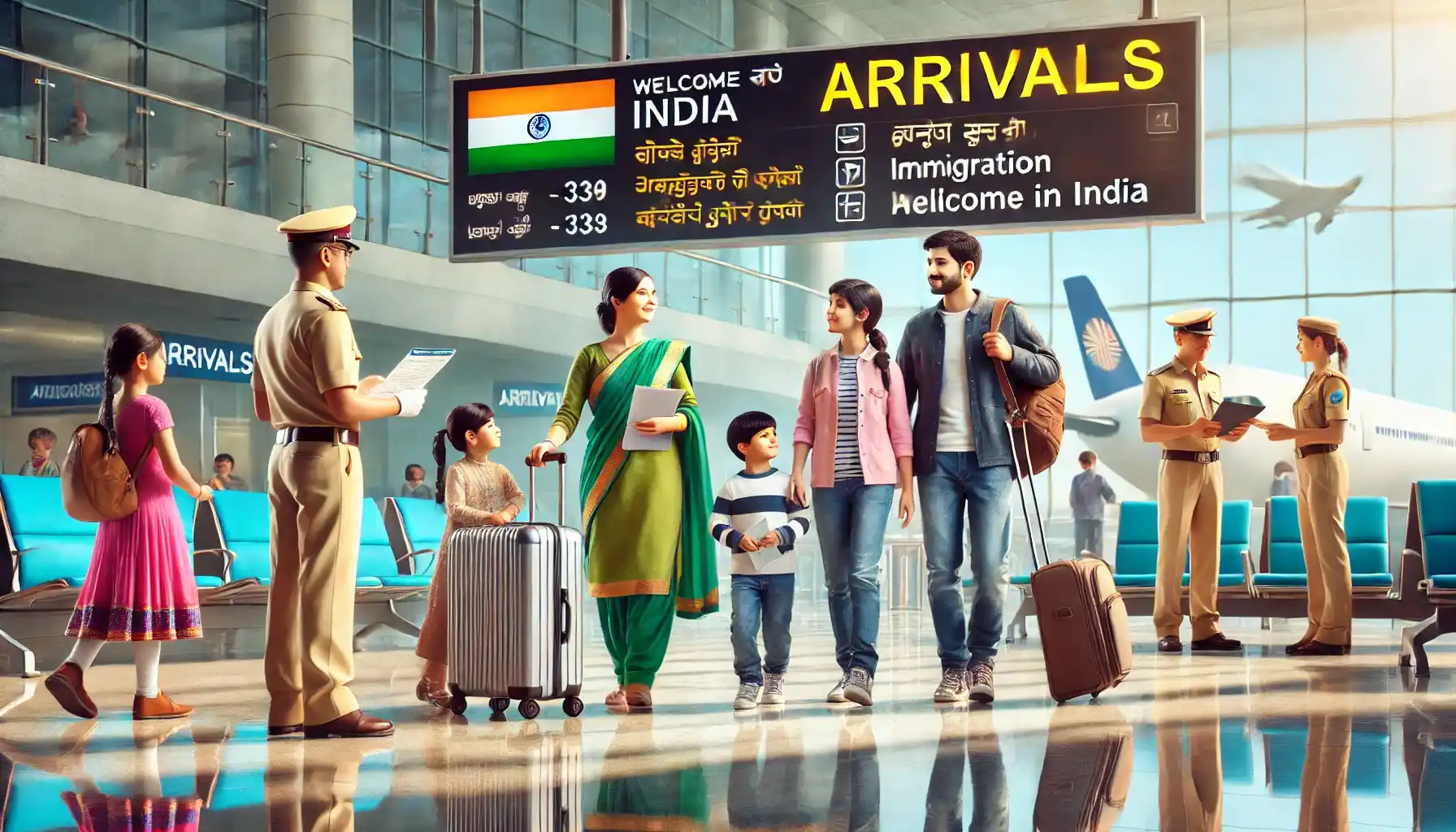Understanding the Essentials of Traveling to India with Children
Traveling to India with children can be a rewarding experience, offering opportunities to explore vibrant cultures, stunning landmarks, and unique traditions as a family. However, international travel with minors requires careful preparation, especially when it comes to meeting specific entry requirements. Ensuring that your children have the appropriate visas, documentation, and health records will help you avoid delays or complications during your journey.
Visa Requirements for Children
1. Individual Visa for Each Child
When traveling to India, every child—regardless of their age—must have their own visa. India’s e-Visa system simplifies the process by offering online applications for various visa types, including tourism, business, and medical visas. Unlike some countries where minors can be included on a parent’s visa, India mandates that each child have a separate visa issued in their name.
Key points to remember:
e-Tourist Visa for Children:
This is the most common visa for families traveling to India for leisure. It allows for double entry and is valid for 30 days.Medical Visa for Children:
For families traveling for medical purposes, a specific e-Medical Visa can be applied for, granting multiple entries and a validity of 60 days.
2. Required Documents for Children’s Visa Applications
To successfully apply for an e-Visa for your child, you will need the following:
Valid Passport:
Each child must have a valid passport. In cases where children under 16 are included on a parent’s passport (in rare instances), ensure the passport meets Indian entry requirements.Passport-Sized Photograph:
A recent photo of the child, adhering to the visa application guidelines.Birth Certificate:
A copy of the child’s birth certificate is often required to verify identity and relationship to the accompanying adults.Vaccination Certificates:
Depending on your country of origin, you may need to present vaccination records, particularly for yellow fever or polio. This is especially relevant for travelers coming from countries where these diseases are prevalent.Consent Letter:
If a child is traveling with only one parent or a guardian, a notarized consent letter from the other parent is often required. For children traveling with someone other than their parents, additional authorization documents may be necessary.
3. Step-by-Step Application Process
The process for applying for a child’s visa mirrors that of an adult application:
Complete the e-Visa Application Form:
Enter your child’s personal details, travel information, and upload required documents online.Upload Supporting Documents:
Ensure all files, including photographs and the passport bio page, meet the specified size and resolution requirements.Pay the Visa Fee:
Use the secure online payment gateway to cover the application fee. The fees are the same as those for adult visas, typically around $60 for an e-Tourist Visa.Submit the Application:
Double-check all information before submission to avoid errors. You will receive an application confirmation number for tracking purposes.
Importance of Accuracy in Visa Applications
Visa applications for children must be completed with the utmost care. Errors, omissions, or inconsistencies in information can result in delays or rejections. For example:
Ensure the name on the child’s passport matches the name entered on the visa application.
Check expiration dates on passports, as India requires at least six months of validity beyond the intended date of entry.
Confirm that the uploaded documents are clear and legible.
By adhering to these guidelines, parents and guardians can secure the necessary visas for their children with minimal stress.

Health and Safety Requirements for Children Traveling to India
When traveling to India with children, ensuring their health and safety is a top priority. From meeting vaccination requirements to preparing for specific health needs, proper planning is essential for a worry-free journey. In this section, we’ll discuss the critical health and safety considerations you should address before embarking on your trip.
1. Vaccination Requirements for Entry into India
Depending on your country of origin, India may require specific vaccinations for entry, especially for children. These measures are in place to protect both visitors and the local population from preventable diseases.
Key Vaccinations to Consider:
Yellow Fever Certificate:
If you’re traveling from or transiting through a yellow fever-endemic country, presenting a valid yellow fever vaccination certificate is mandatory. Without it, travelers, including children, may be denied entry or quarantined.Polio Vaccination:
Some countries require proof of polio vaccination for travelers heading to India, particularly for children under 15. This precaution helps maintain global polio eradication efforts.
Additional Recommended Vaccinations:
While not mandatory, the following vaccinations are highly recommended for children traveling to India:
Measles, Mumps, and Rubella (MMR)
Hepatitis A and B
Typhoid
Rabies (if visiting areas where animal exposure is likely)
Japanese Encephalitis (for rural or extended stays)
Before your trip, consult your pediatrician or a travel health clinic to ensure your child is up-to-date on all necessary vaccinations.
2. Preparing for Medical Needs
In addition to vaccinations, it’s essential to prepare for your child’s specific health needs. This includes compiling medical records, packing essential medications, and understanding how to access healthcare services in India.
What to Include in a Medical Travel Kit:
Prescription medications: Bring enough for the entire trip, along with a copy of the prescription.
Allergy medications: Include antihistamines and EpiPens if your child has severe allergies.
First-aid supplies: Band-aids, antiseptic wipes, and fever-reducing medications are travel essentials.
Oral rehydration salts: Useful for preventing dehydration caused by diarrhea or heat exposure.
Mosquito repellents and nets: Essential for preventing mosquito-borne diseases like dengue and malaria.
Carry Important Medical Documentation:
Health Summary:
A brief document outlining your child’s medical history, allergies, and ongoing treatments can be invaluable in case of emergencies.Vaccination Records:
Ensure these are easily accessible, as they may be required at entry points or for medical care.Emergency Contacts:
Include your child’s pediatrician’s contact details and any relevant travel insurance information.
3. Food and Water Safety for Children
India’s rich culinary scene can be a highlight of your trip, but it’s essential to take precautions to protect your child from foodborne illnesses.
Tips for Safe Eating and Drinking:
Stick to Bottled Water:
Always use sealed, branded bottled water for drinking and brushing teeth. Avoid tap water, ice, and unpasteurized beverages.Eat Cooked Food:
Opt for freshly cooked meals served hot, and avoid raw or undercooked meats and seafood.Wash Fruits and Vegetables:
If you’re buying fresh produce, ensure it’s thoroughly washed or peeled before consumption.Avoid Street Food:
While tempting, street food may not meet the same hygiene standards as established restaurants.
4. COVID-19 Regulations and Precautions
The COVID-19 pandemic has added additional health and safety requirements for international travelers, including children. Ensure you are aware of the latest travel guidelines and prepare accordingly.
Key Considerations:
Testing Requirements:
Check whether India requires pre-travel COVID-19 testing for children. Requirements may vary depending on vaccination status and country of origin.Mask Mandates:
Equip your children with comfortable, well-fitting masks, especially for use in crowded areas and during flights.Travel Insurance:
Consider a comprehensive travel insurance plan that covers COVID-19-related medical expenses and trip interruptions.
5. Managing Parental Consent and Guardianship
If children are traveling with one parent, a guardian, or someone other than their legal parents, additional documentation may be required to ensure their safety.
Required Documents:
Notarized Consent Letter:
If one parent is absent, the accompanying parent must carry a signed, notarized consent letter from the other parent.Guardianship Proof:
For children traveling with non-parents, a formal guardianship authorization letter, along with copies of the parents’ identification, is often required.Legal Custody Documents:
In cases involving custody arrangements, relevant court documents may be needed to avoid complications at immigration.
Ensuring Your Child’s Comfort During the Trip
Long-haul travel can be challenging for children. Here are some tips to make the journey as smooth as possible:
Pack familiar items like toys, books, or blankets for comfort.
Bring snacks and meals your child enjoys to avoid dietary issues during travel.
Encourage frequent hydration and movement during flights to prevent discomfort.
Navigating Immigration and Final Tips for Traveling with Children to India
With visas secured and health preparations complete, the final step is ensuring a smooth immigration process upon arrival in India. Traveling with children comes with its unique challenges, but by following these tips and adhering to regulations, you can make your family’s entry into India stress-free and enjoyable.
1. Preparing for Immigration in India
Immigration checkpoints can be a hectic experience, especially with children in tow. Proper preparation can save time and minimize stress.
What to Have Ready at Immigration:
Printed Visa Copies:
Ensure each child’s e-Visa is printed and readily accessible. Immigration officers will require this alongside the child’s passport.Passport:
Each child must have their own passport. Double-check that it is valid for at least six months beyond your intended date of entry and has two blank pages for stamps.Supporting Documents:
Carry all additional documents that may be requested, such as:Birth certificates
Notarized consent letters (if traveling with one parent or a guardian)
Vaccination records
Key Immigration Tips:
Use Family-Friendly Lines:
Many airports have special lines for families with children, allowing you to bypass long queues.Answer Questions Confidently:
Be prepared to answer basic questions about your trip’s purpose and duration. Ensure your answers align with the information provided in your visa application.Stay Organized:
Use a travel wallet or folder to keep all documents organized and easy to access during immigration.
2. Legal Considerations for Traveling with Children
Legal compliance is essential when traveling internationally with children. India has specific requirements to ensure the safety and security of minors.
Parental Consent Letters:
If a child is traveling with one parent or a guardian, a notarized consent letter from the non-accompanying parent is mandatory. This letter should include:
The child’s full name and date of birth
Details of the accompanying adult(s)
Travel dates and destinations
A statement of consent signed by the non-traveling parent
Guardianship Authorization:
For children traveling with someone other than their parents, a guardianship letter is required. This document should include:
A clear statement of guardianship
Contact information for the parents
Copies of both parents’ identification documents
Court Documentation:
In cases involving custody disputes or legal guardianship, carry relevant court documents to avoid issues at immigration.
3. Planning for a Seamless Arrival in India
After clearing immigration, your family’s adventure in India begins. However, a smooth arrival depends on proper planning.
Transportation from the Airport:
Pre-Book Transfers:
Arrange transportation from the airport to your destination in advance to avoid delays and ensure safety. Many airports offer family-friendly taxi services.Use Trusted Services:
Opt for reputable ride-sharing apps or airport-authorized taxis for a reliable and secure journey.
Accommodations:
Choose accommodations that cater to families. Look for hotels offering child-friendly amenities like cribs, high chairs, and play areas. Notify your hotel of any specific needs in advance.
4. Tips for Traveling with Children in India
India is a family-friendly destination, but navigating its bustling cities and diverse landscapes requires thoughtful planning.

Cultural Sensitivity:
Teach your children about Indian customs and traditions to help them engage respectfully with locals. For example:
Greet with a polite “Namaste.”
Dress modestly, especially when visiting religious sites.
Safety First:
Stay Hydrated:
Carry bottled water at all times to prevent dehydration.Avoid Crowds:
Keep a close eye on children in busy areas like markets or train stations.Keep Essentials Handy:
Have snacks, wet wipes, and hand sanitizers on hand for convenience during outings.
Engage in Family Activities:
India offers plenty of family-friendly attractions, such as:
Visiting Jaipur’s Amber Fort for elephant rides
Exploring the beaches of Goa
Experiencing the thrill of spotting tigers in Ranthambore National Park
5. Returning Home: Final Steps
As your trip concludes, there are a few considerations to ensure a smooth return journey.
Check Visa Validity:
Ensure that your child’s visa is still valid for the duration of your stay in India. Overstaying can lead to penalties or travel restrictions.
Pack Smartly:
Include souvenirs and memories from your trip while ensuring you comply with airline baggage regulations.
Airport Arrival:
Arrive at the airport early to account for security checks and immigration clearance. Family-friendly lounges can provide a comfortable space to relax before your flight.
Why Preparation is Key for Traveling with Children to India
Traveling with children requires more preparation than solo or adult-only trips, but the rewards are worth the effort. By understanding visa requirements, addressing health and safety needs, and planning for immigration and cultural nuances, you can create a memorable and enriching experience for your family.
India’s vibrant culture, stunning landscapes, and rich history offer countless opportunities for adventure and learning. By taking the time to meet all travel requirements and plan ahead, you ensure a smooth and enjoyable journey that your family will cherish for years to come.
Conclusion
Traveling to India with children involves careful planning, but the experience is filled with rich rewards. Ensuring that each child has a valid visa, preparing health and safety documentation, and adhering to legal requirements can make your journey stress-free. With the right preparation, you can immerse your family in the beauty and wonder of India, creating memories that will last a lifetime.
Let Visa-India.co.uk assist you in securing the necessary visas for your family, offering expert guidance and a hassle-free application process. With your paperwork in order, you’re ready to explore the magic of India with confidence and ease.







